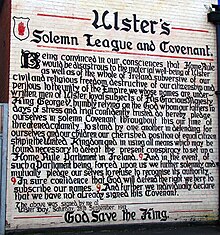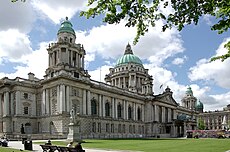Ulster Covenant

Ulster's Solemn League and Covenant, commonly known as the Ulster Covenant, was signed by nearly 500,000 people on and before 28 September 1912, in protest against the
Signing
The Covenant was first drafted by
The Covenant had two basic parts: the Covenant signed by 237,368 men and the Declaration signed by 234,046 women. Both the Covenant and Declaration are held by the Public Record Office of Northern Ireland (PRONI). An online searchable database is available on the PRONI website.

In January 1913, the Ulster Volunteers aimed to recruit 100,000 men aged from 17 to 65 who had signed the Covenant as a unionist militia.[6]
A British Covenant, similar to the Ulster Covenant in opposition to the Home Rule Bill, received two million signatures in 1914.
September 28 is today known as "Ulster Day" to unionists.[7]
The Covenant (for men)
BEING CONVINCED in our consciences that Home Rule would be disastrous to the material well-being of Ulster as well as of the whole of Ireland, subversive of our civil and religious
Home RuleParliament in Ireland. And in the event of such a Parliament being forced upon us, we further solemnly and mutually pledge ourselves to refuse to recognise its authority. In sure confidence that God will defend the right, we hereto subscribe our names.
And further, we individually declare that we have not already signed this Covenant.
The Declaration (for women)
We, whose names are underwritten, women of Ulster, and loyal
Home Rule Bill now before Parliament, whereby it is proposed to drive Ulster out of her cherished place in the Constitution of the United Kingdom, and to place her under the domination and control of a Parliament in Ireland.
Praying that from this calamity God will save Ireland, we hereto subscribe our names.
Demographics
The majority of the signatories of the Covenant were from Ulster, although the signing was also attended by several thousand southern unionists.
Acknowledging this, Carson paid tribute to "my own fellow citizens from Dublin, from Wicklow, from Clare [and], yes, from Cork, rebel Cork, who are now holding the hand of Ulster", to cheers from the crowd.[8]
Robert James Stewart, a Presbyterian from Drum, County Monaghan, and the grandfather of Heather Humphreys, the Minister for the Arts, Heritage and the Gaeltacht in the Republic of Ireland, was one of around 6,000 signatories in County Monaghan, where one quarter of the population was Protestant before the establishment of the Irish Free State.[9] Almost 18,000 people signed either the Covenant or the Declaration in County Donegal.[10]
By county signed in
- Dublin: 768[11]
- Waterford: 56[11]
- Meath: 13[11]
- Limerick: 1[11]
- Mayo: 1[11]
- Louth: 43[11]
- Leitrim: 33[11]
- Kilkenny: 3[11]
- Kildare: 2[11]
- Wicklow: 31[11]
- Not recorded: 84[11]
Signed-in-blood dispute
The signature of
Solemn League and Covenant
The term "
Natal Covenant
The Ulster Covenant was used as a template for the "Natal Covenant", signed in 1955 by 33,000 British-descended


Being convinced in our consciences that a republic would be disastrous to the material well-being of Natal as well as of the whole of South Africa, subversive of our freedom and destructive of our citizenship, we, whose names are underwritten, men and women of Natal, loyal subjects of Her Gracious Majesty Queen Elizabeth the Second, do hereby pledge ourselves in solemn covenant, throughout this our time of threatened calamity, to stand by one another in defending the Crown, and in using all means which may be found possible and necessary to defeat the present intention to set up a republic in South Africa. And in the event of a republic being forced upon us, we further solemnly and mutually pledge ourselves to refuse to recognise its authority. In sure confidence that God will defend the right, we hereto subscribe our names. GOD SAVE THE QUEEN.
References
- ^ Hourican, Bridget (2009). "Sinclair, Thomas". In McGuire, James; Quinn, James (eds.). Dictionary of Irish Biography. Cambridge: Cambridge University Press.
- . Retrieved 29 September 2012.
- ^ "The Ulster Covenant". Government of Northern Ireland. December 2015. Retrieved 28 September 2020.
- PRONI – Historical Topics Series: 5
- ^ "The 1912 Ulster Covenant by Joseph E.A. Connell Jr". 6 March 2013.
- ^ "Ulster Volunteer Force". South Belfast Friends of the Somme Association. Retrieved 29 September 2012.
- ^ "18,000 loyalists expected for 'Ulster Day' march to commemorate UVF formation". Belfasttelegraph – via www.belfasttelegraph.co.uk.
- ISBN 9780717165803.
- ^ "My grandfather signed the Ulster Covenant, Minister says". The Irish Times. 21 January 2016.
- ^ John Tunney, 'The Marquis, The Reverend, The Grandmaster and The Major: Protestant Politics in Donegal, 1868–1933', in William Nolan, Liam Ronayne and Mairead Dunlevy (editors), Donegal: History and Society, p. 688. Geography Publications, Dublin, 1995 (reprinted 2002).
- ^ a b c d e f g h i j k "PRONI Ulster Covenant Search". Public Records of Northern Ireland. [Must search by Parliamentary division to see the numbers]
- ^ "Fred Crawford 'blood signature' legend challenged". BBC News Website. 27 September 2012. Retrieved 29 September 2012.
- ISBN 9780719038730.
External links
- BBC History – Ulster Covenant
- Friends of the Somme – Ulster Loyalty
- Ulster 1912 by Rudyard Kipling on Wikisource
- Ulster Covenant
